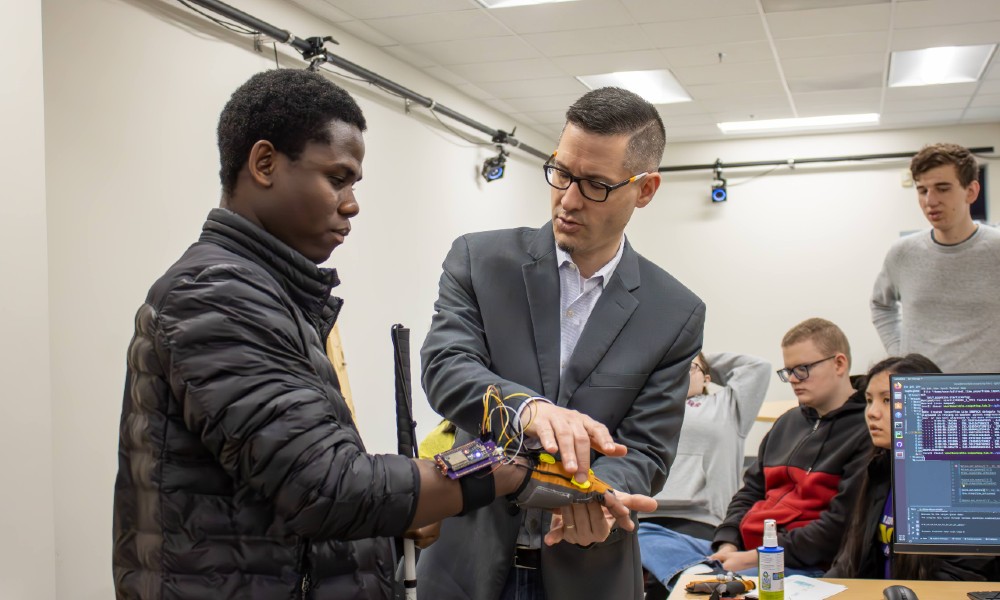Bridging worlds: A collaborative journey in accessible STEM education
News
In a world where barriers often impede access to education, a remarkable partnership between JMU’s Center for STEM Education and Outreach and the Virginia School for the Deaf and Blind is breaking down walls and paving the way for inclusive science, technology, engineering and math learning experiences.
In 2022, Kerry Cresawn, STEM center director, and Dylan Boeckmann (’18, ’19M), VSDB science teacher, embarked on a mission to make STEM accessible to visually impaired students through innovative outreach initiatives.
The journey began when Boeckmann sought an inclusive, hands-on educational experience that would allow his students to interact with peers beyond VSDB. “My students hadn’t taken a field trip since the pandemic,” he explained. Familiar with Cresawn’s dedication to developing inclusive STEM programs from a previous collaboration, Boeckmann inquired about her new outreach programs for middle- and high-school students.
Cresawn suggested adapting a chemistry experience to tactile methods of data collection and analysis. Lindsey Sequeria, a chemistry professor, enthusiastically agreed to facilitate the lesson and collaborate on its adaptation. Through Zoom meetings and collaborative sessions involving Cresawn, Boeckmann, Sequeria and VSDB mobility specialist Lisa Auwarter, the lesson was meticulously modified to ensure accessibility for all students. Every step was documented, leading to the creation of a comprehensive facilitator guide.
In 2023, with the help of JMU student volunteers, VSDB students fully engaged in their first JMU chemistry lab experience. They investigated the synthesis of bioplastic films from natural materials found in shrimp shells and explored how the molecular structure of added plasticizers affected the film’s physical properties. “JMU students provided verbal guidance and safety oversight as needed. They were well-prepared to explain and facilitate discussions,” Cresawn said.
Their approach challenges existing experiences, often limited to providing materials in Braille, enlarging text, utilizing assistive technology, offering audio versions of textbooks, or modifying assignments. Instead, this model focuses on developing novel lessons inspired by faculty-driven learning experiences at JMU. This approach requires identifying faculty whose expertise transcends visual limitations, ensuring that lessons are accessible, engaging, and meaningful.
April 3 marked the second year of hosting the event, and Engineering professor Jason Forsyth guided VSDB students in an activity to explore environmental issues. Students utilized data collected by environmental sensors, transforming it into musical sounds and pitches. Then, they analyzed the sounds to identify potential locations for an indoor garden.
“Sensory technology is powerful,” Forsyth explained. “Sonifying the data enabled students to sense and measure things that would have been normally hidden from them. They were able to find low, medium and high levels of the various sensory measurements they collected.”
“We took something very visual and made it auditory, making the data accessible to all VSDB participants,” Cresawn remarked.
After the lesson, the students visited Forsyth’s lab to learn about his research on wearable computing systems. They engaged in hands-on exploration and interaction with haptic feedback devices, which provide tactile sensations or vibrations. Through this experience, students gained a deeper understanding of sensory technology.

“When we visited the research lab, we had envisioned a certain way that our system would navigate people through space,” Forsyth explained. “Observing the students adapt the system to their needs was very interesting. Watching their movements as they navigated to a particular location offered a fresh perspective.”
“VSDB and JMU students connected over many commonalities. The interactions were rewarding and encouraging,” Cresawn said, highlighting the positive impact of innovative STEM learning experiences.
Boeckmann was impressed by Forsyth’s willingness to seek feedback and make his program even more accessible, showing a genuine commitment to inclusion and accessibility. “I had high expectations for this trip, which were met and exceeded.”
Given the partnership’s success, Cresawn will continue arranging trips for VSDB students in the fall and spring semesters.
“I hope that our work has demonstrated a more creative way to adapt hands-on learning and encourages other institutions to identify research experiences that can be adapted for visually impaired students,” Cresawn said.
“JMU and VSDB are bridging worlds, creating a more inclusive and accessible learning environment for all,” she added.
